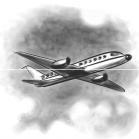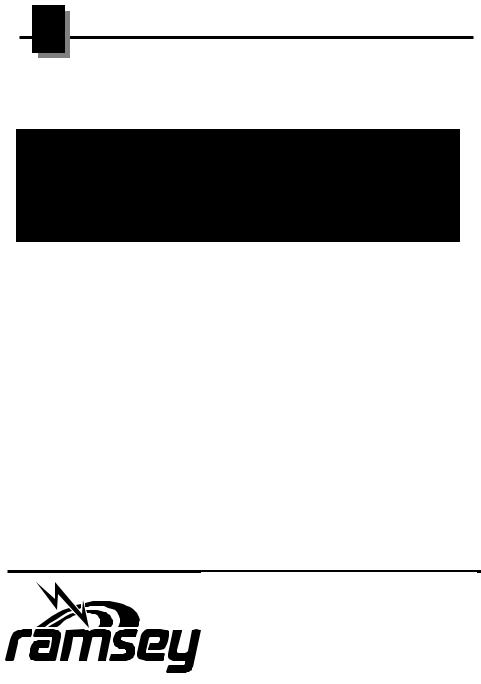Ramsey ABM1WT Manual

PASSIVE AIR
BAND MONITOR
Ramsey Electronics Model No. ABM1WT
Imagine monitoring the entire 118 to 136 MHz Aircraft band with no tuning! Then imagine being able to bring your receiver onboard aircraft to hear what’s going on and not having to worry about interference! This monitor give you access to air traffic signals from aircraft and airports . . . just pop in the earbuds and listen to what’s out there!
•Monitors the entire aircraft band 118 to 136 MHz without tuning!
•Passive design, can be used onboard aircraft, no local oscillator, creates no interference.
•Pick up local aircraft and tower communications
•Volume and Squelch controls allow for discriminating listening
•Fits in your pocket or clip to your belt
•Patented circuit and design.
•Runs on 9VDC and includes ear buds.
•Great for air shows!
ABM1 • 1

PARTIAL LIST OF AVAILABLE KITS:
RAMSEY TRANSMITTER KITS
•FM10A, FM25B, FM30, FM Stereo Transmitters
•FM100B, FM35 Professional FM Stereo Transmitters
•AM1, AM25 AM Broadcast Band Transmitters
RAMSEY RECEIVER KITS
• FR1 FM Broadcast Receiver
• AR2 Digital Aircraft Band Receiver
• AR1 Aircraft Band Receiver
• SR2 Shortwave Receiver
• SC1 Shortwave Converter
RAMSEY HOBBY KITS
•LBC6K Laser Beam Communicator
•SG7 Personal Speed Radar
• SS70C Speech Scrambler/Descrambler
• DCI1 DTMF Controller
•LLS1 Laser Light Show
•MD3 Microwave Motion Detector
•LEDS1 LED Strobe Light
•BE66 Blinky Eyes Animated Display
•LTS1 Laser Trip Sensor
•ICI1C Infrared Switch Control Interface
RAMSEY AMATEUR RADIO KITS
•HR Series HF All Mode Receivers
•DDF1 Doppler Direction Finder Kit
•QRP Series HF CW Transmitters and QAMP Power Amplifiers
•CW7 CW Keyer
RAMSEY MINI-KITS
Many other kits are available for hobby, school, scouts and just plain FUN. New kits are always under development. Write or call for our free Ramsey catalog.
Passive Air Band Monitor
Ramsey Electronics publication No. ABM1
December 2005
COPYRIGHT ©2005 by Ramsey Electronics, Inc. 590 Fishers Station Drive, Victor, New York 14564. All rights reserved. No portion of this publication may be copied or duplicated without the
written permission of Ramsey Electronics, Inc. Printed in the United States of America.
ABM1 • 2

Ramsey Publication No. ABM1
Manual Price Only $5.00
INSTRUCTION MANUAL FOR
PASSIVE AIR BAND MONITOR
TABLE OF CONTENTS |
|
Introduction .......................................... |
4 |
Circuit Description................................ |
4 |
What You Can Expect to Hear ............ |
6 |
Schematic ............................................ |
8 |
ABM1 Alignment and Adjustment...... |
12 |
Conclusion ......................................... |
13 |
ABM1 Specifications.......................... |
14 |
Warranty ............................................ |
15 |
RAMSEY ELECTRONICS, INC.
590 Fishers Station Drive
Victor, New York 14564
Phone (585) 924-4560 Fax (585) 924-4555 www.ramseykits.com
ABM1 • 3
INTRODUCTION
Everyone from aviation enthusiasts to armchair listeners to schoolchildren can enjoy listening to aircraft and airport signals with the ABM1. It’s an Aircraft receiver that does not radiate RF signals so you can take it to the airport and even onboard aircraft without worrying about causing interference. In order for the receiver to be non-interfering, no local oscillators or mixers are used. The unit directly converts the entire Aircraft Band meaning that the user can hear all local aircraft traffic at once. Stronger RF signals will produce a louder audio signal than weaker signals, making it easy for the user to pick out a specific conversation to listen to. This also has the advantage of allowing the user to hear both sides of a conversation without re-tuning the receiver. In fact, you never tune the ABM1, making it perfect for beginners and kids learning the fun of both electronics and aviation. We think you’re going to find the Airband Monitor kit a useful and educational receiver that you’ll be enjoying for years to come.
CIRCUIT DESCRIPTION
We’ll take the circuit in bite size chunks and explore each section to see how the kit works. Follow along on the schematic if you wish; we’ll work from input to output.
Antenna Input/Audio Output
Jack J1 allows the connection of a standard 3.5mm headphone jack to the ABM1. The headphones will provide two functions. Obviously they provide the audio for the user to listen to the aircraft band. The headphone wires are also used as an antenna for the ABM1. L2 is a high impedance to Radio Frequencies (RF) keeping the RF from traveling back to the Audio Amplifier.
1st Band-pass Filter
C1 is a coupling capacitor that allows the RF signal picked up by the headphone wires to pass into the 1st Band-pass filter. This filter is made up of M1, C2, L3, C3, M2, and C4. M1 and M2 are micro-strip inductors that are actually formed from traces on the circuit board. This filter is designed to pass only frequencies between 118 MHz and 136 MHz, the aircraft band.
RF Amplifier
The purpose of this stage is to increase the signal strength of the previously filtered signal. C5 is another coupling capacitor; it takes the 118 to 136 MHz RF signal from the 1st Band-pass filter and allows it to move to the RF Amplifier while isolating DC. U1 is a Monolithic Amplifier that provides about 18 dB of gain for our signal. Its frequency range is from DC to 1 GHz. Since component leads and foil runs can act as antennas at high frequencies C6 is used to prevent high frequency signals from entering U1 directly from the air. R1 sets the bias for the amplifier while C7 and C9 filter the power supply.
ABM1 • 4
2nd Band-pass Filter
The 2nd Band-pass filter is a copy of the first. Its job is to further filter the RF signal. It consists of coupling capacitor C8, and filter components M3, C10, L4, C11, C12, and M4.
AM Detector
The AM detector consists of C13; you guessed it, it’s another coupling capacitor that passes the signal to U2’s non-inverting input while isolating DC. R6 provides the bias for the detector while C17 provides power supply filtering. C15 is used to prevent high frequency signals from entering U2 directly from the air. R2 sets the input impedance of the stage to 51 ohms. This is important for proper frequency response from the 2nd Band-pass filter, it needs to see a 50 ohm load. C14 essentially places the inverting input at AC ground. The Logarithmic Amplifier U2 provides a high amount of gain, detects or turns the RF signal in to audio, and provides a DC output voltage proportional to its input signal strength.
Squelch
The squelch circuit allows the user to set the RF signal level that the Audio Amplifier will amplify and pass. C19 is a coupling capacitor that passes the detected audio from U2 to the audio amplifier section while preventing U2’s DC output from being affected by the setting of R11. R9 prevents the AC output of U2 from being shorted to ground if the squelch is closed. R3, R4, and R5 make up a voltage divider that allows the user to set the voltage (squelch level) at U3 pin 3 through R7 (filtered by C16) between 0.1 VDC and 2.0 VDC. U3 is an operational amplifier being used as a comparator. This circuit compares the voltage from the voltage divider and DC level from the Detector’s output through R8 (filtered by C18). When the Detector’s DC level, which is proportional to U2’s RF input, at U3 pin 2 falls below the level set by the operator (U3 pin 3). U3’s output at pin 1 goes high (9 Volts) turning on Q1. Q1 is an N-channel Enhancement Mode Field Effect Transistor. The positive voltage from the comparator U3, pin 1, is felt on the gate of Q1, turning it on, which results in a very low Drain to Source resistance. This low Drain to Source resistance shorts the audio signal coming through R9 to ground. This prevents the audio from passing to the audio amplifier so nothing is heard in the headphones. When the input signal to U2 increases the DC output voltage at U2 pin 4 will increase. When this voltage being felt on U3 pin 2 increases above the voltage on U3 pin 3 (set by the user) U3 pin 1 will go low (0 Volts). With 0 Volts on the gate of Q1 it turns off which causes the Drain to Source Resistance to become very high. With Q1’s Drain to Source resistance high the detected audio from U2 is allowed to pass through C19 and R9 into the Audio Amplifier. Now received audio is heard in the headphones.
ABM1 • 5
